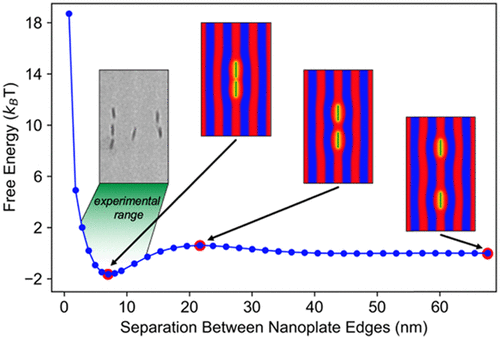Abstract
Within ordered poly(styrene-b-methyl methacrylate) (PS-b-PMMA) block copolymer (BCP) lamellae, oriented nanoplates [gadolinium trifluoride doped with ytterbium and erbium, GdF3:Yb/Er (20/2 mol %)] grafted with polyethylene glycol assemble into aligned strings at small interparticle separations. Herein, we investigate the origin of these aligned assemblies using X-ray scattering, electron microscopy, and hybrid particle/self-consistent field theory simulations. From previous reports, the insertion of a nanoplate in a BCP microdomain is expected to perturb the polymer chains and produce a local domain bulge as the PS/PMMA interface distorts to optimize conformational entropy. While experimental techniques are unable to directly resolve this small distortion, the two-dimensional simulations of the equilibrium BCP nanocomposite structure clearly show bulge formation around the nanoplates. As a function of particle separation, the potential of mean force (PMF) calculation reveals a global minimum corresponding to an equilibrium interparticle spacing of 7.0 nm, which agrees well with a mean experimental value of 6.4 nm. Furthermore, the PMF calculation exhibits a small activation barrier due to the high curvature penalty between two nanoplates at a separation distance of 21.7 nm. Ultimately, nanoplate strings form to fulfill the criteria where the energy benefit of decreasing interfacial area and minimizing chain stretching outweighs the energy penalty associated with reducing the translational entropy affiliated with evenly distributing the nanoplates. The simulations also illustrate a narrow tolerance for orientation angles, supporting the high degree of nanoplate alignment observed experimentally. We anticipate that the ability to align and couple anisotropic nanoparticles in BCPs presents opportunities to create functional polymer nanocomposites with orientation-dependent properties.
